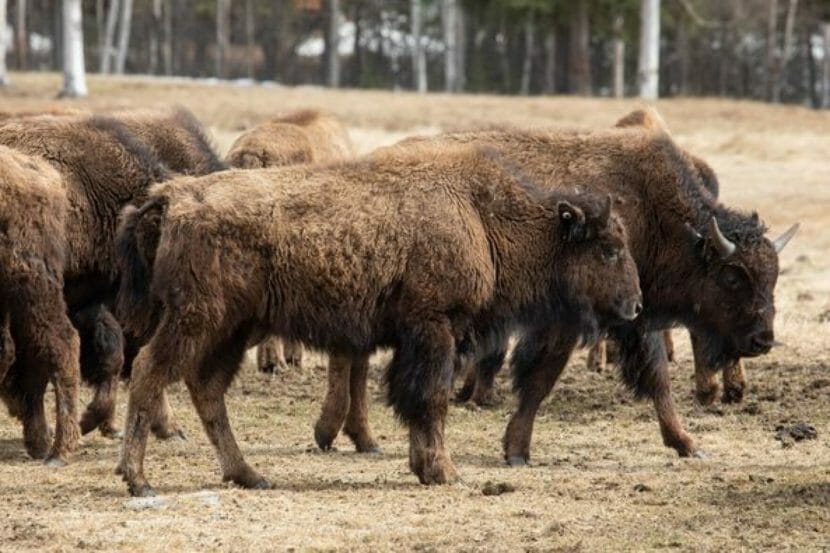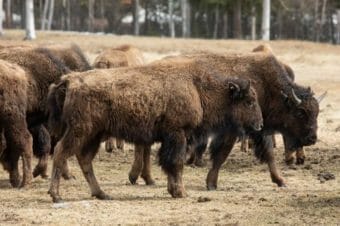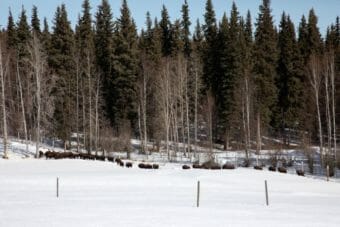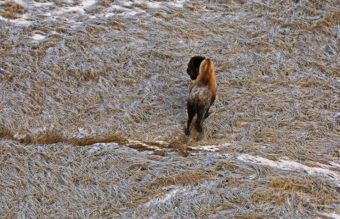
A group of young wood bison are being transported to the Lower Innoko River region in Western Alaska. It’s the latest step in a decades-long effort by state and federal agencies and Alaska Native groups to re-establish the animals in Alaska.
The 28 yearling wood bison are part of a group form Alberta’s Elk Island National Park that were trucked to Fairbanks in April. Alaska Department of Fish and Game wood bison biologist Tom Seaton says the animals spent the last three months at the University of Alaska Fairbanks Large Animal Research Station.
“When we first got them, they were just kind of bony calves that had just been weaned, and we wanted to get their body condition up. So we got them on some really good hay from Delta Junction and supplementing them with alfalfa pellets to try to improve their protein so they can gain some muscle mass,” he said. “This summer was a great growing summer, and you can really see it in the bison. Some gained as much as 200 pounds since April, and it’s pretty amazing.”
The even mix of female and male wood bison are destined to join a herd seeded by animals transplanted from Canada to the Innoko River region in Western Alaska in 2015. Seaton says the young bison were separated into four groups of seven in preparation for this week’s trip.
“They’ve had some time to develop their social relationships in those groups of 7, which is important because you don’t want certain individuals in a container working out their dominance hierarchy when they’re being transported,” Seaton said.
The bison are traveling in four customized steel shipping containers, which longtime project partner Carlile Transportation trucked from Fairbanks to Nenana Wednesday.
Carlile Transportation senior account executive Eleanor Harrington says the company provides the service for a nominal fee because it supports the wood bison project.
“This is just one of the coolest projects,” she said. “My background is in animals, so I’m personally very invested in this.”
From Nenana, it’s a three-to-four-day barge voyage along the Tanana, Yukon and Innoko Rivers to a pre-staged release site on the Innoko. Seaton says 2 biologists are accompanying the wood bison on the river trip, during which overheating is the biggest concern.
“They take shifts and monitor them 24 hours a day, and there’s air conditioning units on there, and temperature and humidity sensors,” he said.
Seaton says the journey is stressful for the wood bison, which will be released into a large, fenced area to adjust to their new environment. He says the enclosure was constructed by Holy Cross and Shageluk residents at a site along the Innoko River in an area where the existing herd of around 130 animals gathers for the rut this time of year.
“We need to connect them with the wild bison so they can join that social group and learn about where to eat and where to go, and what to do and all that from the wild bison,” he said. “So if we can get the bison settled, and then the wild bison show up, then we’ll turn them out.”
Seaton emphasizes that bison are very good at finding other bison.
“Young bison want to be with adult cows and adult cows want to keep young bison with them, and so even for young bison that they don’t know, there’s an attraction there, a magnetism there that will work in our favor,” he said.
Seaton says a grant from the Bureau of Land Management is covering the $300,000 cost of this latest phase of the reintroduction project.
He says another 11 bison from the same group of yearlings brought from Canada in April are remaining behind in Fairbanks because they are still a little too small to be released into the wild. He says that group will likely join the others along the Innoko River next summer.


